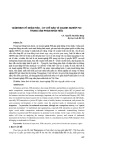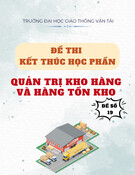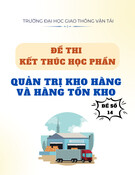
* Corresponding author.
E-mail address: wateniwut@polikant.ac.id (W. A. Teniwut)
©2019 by the authors; licensee Growing Science, Canada.
doi: 10.5267/j.dsl.2019.6.001
Decision Science Letters 8 (2019) 393–410
Contents lists available at GrowingScience
Decision Science Letters
homepage: www.GrowingScience.com/dsl
Selecting top fisheries sub-sector in each sub-district for sustainable development of
archipelagic region in Indonesia: A hybrid fuzzy-MCDM approach
Wellem Anselmus Teniwuta*, Syahibul Kahfi Hamida and Marvin Mario Makailipessyb
aFisheries Agribusiness Study Program, Tual State Fisheries Polytechnic, Indonesia
bFishing Technology Study Program, Tual State Fisheries Polytechnic, Indonesia
C H R O N I C L E A B S T R A C T
Article history:
Received May 10, 2019
Received in revised format:
May 18, 2019
Accepted June 14, 2019
Available online
June 14, 2019
As archipelagic region, an effort to effectively enhance and accelerate the development of each
sub-districts to boost the rapid development of Southeast Maluku district in Indonesia cannot
happen as long as the local government fails to identify the real potentials and power in fisheries
sector of each sub-districts. Identification of each sub-district fisheries top sub-sector has to be
based on the human resources, natural resources, infrastructure, current and potential market,
current policy of local and central government. A multi-criteria decision making (MCDM) is one
of the powerful tools to provide a better result based on complicated factors involved. This paper
proposed an integrated MCDM, to tackle the complicated factors in order to provide the best
commodities on each sub-districts. Bottom-up concept was used to have a comprehensive result,
by combining Fuzzy logic with Analytical Hierarchy Process (AHP) to measure the factors using
fuzzy logic with Technique for Order of Preference by Similarity to Ideal Solution (TOPSIS) for
determining the top sub-sector in fisheries. For comprehensive assessment of macro factors the
study used experts ranging from government, scientists, practitioners to NGOs. On the other
hand, for micro factors the survey used field instructor, field officer, fishers and farmers. The
results provide a guideline for local and central government to form a better policy regarding the
development of each sub-district including farmers, fishers and coastal communities in each sub-
district to focus on commodities that benefited their regions’ resources and coastal community’s
capabilities. By doing so, we hope to contribute on crafting an integrated and collective path on
reaching the goal which is the welfare of coastal region.
.2018 by the authors; licensee Growing Science, Canada©
Keywords:
MCDM
Fuzzy logic
Top sub-sector
Southeast maluku
Fisheries
1. Introduction
The direction of development in Indonesia starts from rural region being preached by President of
Indonesia, Joko Widodo. In regards to the notion of bottom-up development, central government issued
guidance in form on National Medium Term Development Plan (RPJMN) as roadmap for nation
development in every sector industry, which is currently used for developing Indonesia (Bappenas,
2014). Although the main problem with the roadmap itself is the actual content document was too
general and in some cases had no relationship with the current conditions of the regions, there has been
an effort to make it relatable with each region by having each local government to form Regional
Medium Term Development Plan (RPJMD) based on the national plan. In Southeast Maluku District
the RPJMD currently is still working on the road map, therefore the need for an input from every
stakeholder regarding the matter is crucial. The policy always change depending on government regime
by political background which makes its hard to have a consistent development plan, added with the

394
empirical conditions where most of central and local government often have vague and rhetoric policies
on developing regions. In some cases, local government in particular used to have limited knowledge
on the right strategy on each part of region and based on their actual regional competitive advantage,
which cause the slower regional development (Del Sol & Kogan, 2007; Havle & Kılıç, 2019).
Accelerating the development of each region has to be based on each region core competitiveness.
Factors namely natural resources, potential market, labor capabilities and infrastructure have to be
considered precisely in order to reach the economic and sustainable development of each region (Hill
& Brennan, 2000). There is a fact that there are several factors which directly influence the development
of each region and there are also factors that have significant role on the success of regional
development such as rapid growth of information technology and technology in general (Zhang, 2009),
transportation (Rokicki & Stępniak, 2018), and growth of population (Shahraki, 2017). By looking into
all the factors, the process on identification of the best feature and product of each region should
become easier and accurate, which are indicted as the keys for regional economic development (Loizou
et al., 2019).
As region consists of small islands and located far from the main islands and cities in Indonesia,
Southeast Maluku District posses certain and distinct characteristics especially on its current
infrastructure development, human resources capabilities, connectivity, and knowledge on the use of
technology. Based on the previous studies from Teniwut et al., (2017a); Teniwut and Teniwut (2018);
Hamid et al., (2017); Picaulima et al., (2017); Teniwut et al., (2017b), the infrastructure in general is
underdevelopment compared with some big cities in the region also in Kei Islands there is still a huge
gap on urban and rural area, coastal communities in the region mostly have low formal educational
background where most of their knowledge are based on their experience and knowledge pass by their
elders. In addition, the connectivity in the regions also provide a challenge for supply chain.
The more complex variables have to be considered in addition to the empirical challenge in Southeast
Maluku District resulted a delicate and complicated problems to be dealt with. Thus, MCDM is a tool
that can help us provide decision by considering all factors related. Since 1960s Multi-criteria decision
making (MCDM) is one of the most powerful tools for ranking alternative decisions based on a
complicated factors (Gou & Liao, 2007; Wang et al. 2009). The use of MCDM techniques such AHP
has been widely used across all research fields, for instance, Ayhan (2020) used Fuzzy AHP for supplier
selection; Giamalaki and Tsoutsos (2019) used AHP and GIS for solar power Installation; Teniwut et
al. (2019) used AHP and spatial analysis for seaweed information center location; Al Mamun et al.
(2019) used Fuzzy AHP to measure water surface quality; Vyas et al. (2019) developed rating system
for green building in India, and Hayle et al. (2019) used AHP for error analysis in transatlantic flight.
As mentioned by previous researches about the weakness and advantage of MCDM tools, we need for
a combination of MCDM tools to solve a complicated matter. By doing so, the limitation from one tool
can be covered by another one. The use of AHP combined with other MCDM tools has been executed
previously especially for AHP and TOPSIS, where these two MCDM methods have been used widely
to solved various problems in MCDM (Zyoud et al., 2017). AHP was used to determine the preference
weights and TOPSIS was used for ranking the best alternatives (Hsieh et al., 2018). As popular as these
two methods, Dursun and Karsak (2010) suggested the use of fuzzy logic with MCDM methods to
provide a better and more effective results in solving complex problems. Application of Fuzzy AHP
and Fuzzy TOPSIS has been used in wide-range of fields, for instance in medical (Büyüközkan & Çifçi,
2012), Education (Turker et al., 2019), logistic and operational (Sirisawat & Kiatcharoenpol, 2018),
environment development (Singh & Sarkar, 2019), maritime transportation (Celik & Akyuz, 2018),
bank and financial sector (Mandic et al. 2014), human resources (Chou et al. 2019), construction
(Taylan et al. 2014) and electro and electricity (Roy & Dutta, 2017).
Thus, we consider the empirical condition complicity of the problem on selecting the top commodities
on each sub-districts in Southeast Maluku, and focused on using the hybrid fuzzy AHP-TOPSIS to
obtain top fisheries sub-sectors in each sub-district in the region. Fuzzy AHP is used to determine the

W. A. Teniwut et al. / Decision Science Letters 8 (2019)
395
weight and Fuzzy TOPSIS was selected to rank the top fisheries sub-sector namely fishing sub-sector,
marine culture sub-sector, post-production and processing fisheries, and marine ecotourism.
Furthermore, the structure of the study is constructed as follows: the methodology contained study
location, data collection and analysis method. The next section is devoted to the result followed by
discussion and conclusion.
2. Material and method
2.1. Study Location
Widely known as the world's largest archipelago country, Indonesia estimated has over 18,100 islands
with over 60% of its people living in small islands region (CTI-CFF, 2009). One of the commonly
known archipelagic regions with rich biodiversity and major fish supply in Indonesia is located in
Maluku Province, where Kei Islands are among them. The study located in Kei Islands which is
Southeast Maluku District. There are two administrative regions in Kei Islands, aside of Southeast
Maluku District located in Kei Besar Island and Kei Kecil Islands, there is also Tual City located in
Dullah Islands. As seen in Fig. 1, Southeast Maluku geographically is located in 5º to 6,5º south latitude
and 131º to 133,5º east longitude and consists of two largest islands with 25 small islands in the region.
The infrastructure and road access is significantly better in Kei Kecil Islands compared with Kei Besar
island. This region covers more than ± 7.856,70 km² where almost half of this region is water at ±
3.180,70 km² and land area is ± 4.676,00 km². This region is located in average ± 100m to 115m below
sea level. In 2016, the population of Southeast Maluku district was 98.684 (Statistic Indonesia, 2017).
There are 11 sub-districts in southeast Maluku District, where six sub-districts are located in Kei Kecil
islands and five sub-districts are located on larger Kei Besar island with total of 191 villages. Southeast
Maluku District is widely known as one of supplier of fish in Indonesia, with high abundant of fish, in
addition to good quality of water quality and long white sand beach, the region also supplies large
number of seaweed account for 6.455,70 ton in 2017 contributed to IDR 38.734.202.000,- in 2017
(Marine and Fisheries Office of Southeast Maluku District, 2017), and sea cucumber. Most of its people
live in coastal regions, as the result the dependency rate to the sea is higher than other regions in
Indonesia. Fisheries sector contribute the largest portion on district regional GDP. In 2016, number of
fishermen were 5.620 compared with the number of mariculture farmers at 4.652 (Statistic Indonesia,
2017).
Fig. 1. Study Location

396
2.2. Method
The research framework of this study is illustrated in Fig. 2, which consists of two parts. In the first
part, we calculate the weights for each criterion using fuzzy AHP and in the second part, we use the
weights to rank the best alternative with Fuzzy TOPSIS. All MCDM calculation are run using Microsoft
Excel (Fig. 2). The experts used on the study are divided into three categories; namely academicians
which consist of researchers and lecturers in business and economic field; practitioners including
farmers, fishers, entrepreneur related to fisheries commodities; government employee including
instructors, fisheries and marine affairs and board of regional development planning. In this paper, we
used the computational technique based on the fuzzy numbers defined by Gumus (2009) (See Table 1).
2.3. Fuzzy AHP
A conventional AHP has some limitations due to the application, such as the judgmental scale is
unbalanced and absence of uncertainty; selection of judgment is subjective, therefore Fuzzy AHP was
introduced to tackle the previous limitations. Fuzzy AHP approach was presented by Chang (1996),
where pairwise comparisons are established using a nine-point scale and converts experts’ preferences
into available alternatives such as equally, moderately, strongly, very strongly or extremely preferred.
Fig. 3 shows the hierarchical structure of decision problem to select the top commodity in fisheries and
marine sector for each sub-district in the Southeast Maluku district.
Fig. 2. Proposed research framework
The fuzzy AHP analysis in the study based on Sun (2010), where there are two steps in fuzzy AHP
analysis.
Step 1: Pairwise comparison matrix on all criteria by asking which criterion is more important, as
shown below matrix :
1
1⋯
⋯
⋮⋮
⋱⋮
⋯1
1
1
⁄1⋯
⋯
⋮⋮
1
⁄1
⁄⋱⋮
⋯1
(1)
where

W. A. Teniwut et al. / Decision Science Letters 8 (2019)
397
9,8
,7
,6
,5
,4
,3
,2
,1
,1
,2
,3
,4
,5
,6
,7
,8
,9
1 (2)
Step 2: To define fuzzy geometric mean and fuzzy weights of each criterion, we use geometric mean
(Hsieh et al., 2004)
⊗…⊗
⊗…⊗
⁄ (3)
⊗…⊗
⊗…⊗
(4)
where, is fuzzy comparison value of criterion compared with criterion, thus, is geometric
mean of fuzzy comparison criterion to each criterion, is the fuzzy weight of the th criterion,
indicated by TFN, ,
,. Where represents the lower values, is associated
with the middle value and represents the upper values of fuzzy weight of the th criterion.
Fig. 3. Hierarchical structure of decision problem.
The consistency on matrix we used is standard consistency ratio (CR) as follows:
, (5)
where RI is a random index, and CI is consistency index. In addition to determine CI, we used the
following equation:
1 (6)



![Hệ thống thông tin quản lý quan hệ khách hàng PT Hasrat Abadi Merauke: [Thông tin chi tiết/Hướng dẫn...]](https://cdn.tailieu.vn/images/document/thumbnail/2020/20200601/lucastanguyen/135x160/7281591000090.jpg)
![Dự án kinh doanh thương mại điện tử Shinning Together [Mới nhất]](https://cdn.tailieu.vn/images/document/thumbnail/2018/20181014/dotuananhanh/135x160/8261539527394.jpg)












![Đề kiểm tra Quản trị logistics [mới nhất]](https://cdn.tailieu.vn/images/document/thumbnail/2025/20251015/2221002303@sv.ufm.edu.vn/135x160/35151760580355.jpg)
![Bộ câu hỏi thi vấn đáp Quản trị Logistics [năm hiện tại]](https://cdn.tailieu.vn/images/document/thumbnail/2025/20251014/baopn2005@gmail.com/135x160/40361760495274.jpg)







